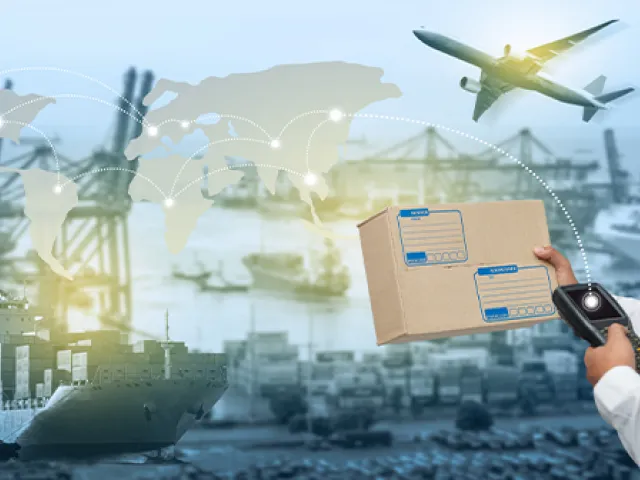Table of contents
Amazon's growing impact on healthcare logistics is just one of the topics covered in the first episode of "Orchestrating Outcomes," a new video series presented by TraceLink featuring in-depth interviews with leading voices from the worlds of logistics, external manufacturing, procurement, direct supply, clinical supply chain, and much more.
The Orchestrating Outcomes series delves into the multifaceted challenges and promising opportunities of supply chain digitalization. Hosted by Henry Ames, General Manager of Logistics Orchestration at TraceLink, the inaugural episode features supply chain digitalization insights from Guy Courtin, Vice President of Industry & Global Alliances at Tecsys. A former industry analyst with over 25 years of experience in supply chain technology, Courtin offers a deep dive into the impact of digitalization on the evolving supply chain management landscape.
Drawing a parallel between the retail and healthcare industries, Courtin noted that just as consumers expect quick and reliable service from retailers like Amazon, patients are beginning to expect similar levels of service from the healthcare supply chain. This shift is driving life sciences, healthcare, and supporting service provider organizations to adopt more advanced supply chain practices, focusing on improving the speed and accuracy of service delivery. The trend is gaining additional momentum now that Amazon itself has entered the healthcare market.
"Amazon has made the notion of two-hour, two-day delivery as status quo," Courtin said. "What we're seeing on the healthcare side is more and more healthcare providers are starting to think, 'You know what, we need to have the same attitude."
Data quality rises in importance as supply chains go digital
Courtin also emphasized that performing regular data audits to ensure data quality is critical to the success of any supply chain digitalization initiative.
"If I'm in healthcare and I'm supplying a hospital network, and that hospital network performs a lot of cancer treatments, then I need to have the right data associated with that. I need to make sure that my data sources coming from my suppliers or my transportation nodes or whatever nodes are out there are clean," he said. "And then how am I processing the data and then sharing it moving forward? So, I think that is the first thing we all have to do. Do that hard audit."
It's also important to note that not all data holds the same level of importance. Organizations must prioritize mission-critical data while also recognizing that some data, while useful, may not be essential for day-to-day operations. This prioritization helps in managing resources more effectively and ensures that the most crucial information is accurate and readily available.
Courtin also stressed that a data audit is not a one-time task. Continuous monitoring and regular audits are necessary because supply chains and business needs are constantly changing.
Digital data sharing is critical with outsourcing on the rise
As outsourcing in the pharmaceutical industry expands, the need for seamless digital integration and greater transparency across complex global networks has become more critical than ever before.
In Part 2 of the Orchestrating Outcomes interview, Courtin emphasizes the need for organizations to establish a robust digital communication infrastructure to streamline operations and ensure data accuracy across the entire network. One underlying problem standing in the way of this objective is inconsistency in how data is shared and managed. This leads to potential disruptions and inefficiencies within the supply chain.
Another challenge is convincing your partners to be more open and transparent with you when it comes to sharing data across the digital supply chain. It starts with showing your partners the value of transparency, openness, and better communication.
"If you're onshoring, nearshoring, friendshoring—whatever it is you're doing—and your network is spreading, how do you make sure you convey to your suppliers and to everybody in your network the value that they could get by being more digitally open with you?" Courtin said. "For example, are there ways that you can go and say, 'Listen, if you are able to be more transparent with me, I get more insight into what you're doing, and I could be more precise in my ordering."
Be sure to watch Part 1 and Part 2 of our Orchestrating Outcomes interview with Guy Courtin for additional insights on how to conduct a data audit, how to achieve a single view of data across the supply chain, the challenges of change management, the impact of the Internet of Things, and much more.
The network platform approach to supply chain digitalization
Companies across the end-to-end life sciences and healthcare supply chain are aiming to digitalize relationships with trading partners to achieve critical business goals, including:
- Dramatically improving customer service levels by reducing long supplier lead times.
- Reducing costs and improving operational efficiency through better visibility into order status with suppliers and production status with CMOs.
- Reducing stockouts by improving forecast accuracy and supply planning.
The fastest and most cost-effective way to achieve these goals is by integrating with all of your supply chain partners on a digital network platform. Contract TraceLink to learn more about how to leverage a network platform to rapidly advance your supply chain digitalization projects.






